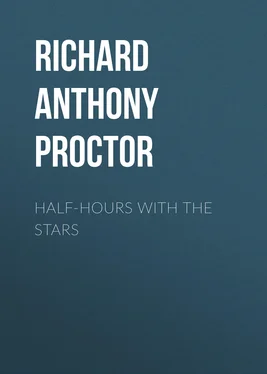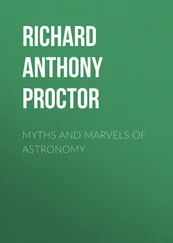Richard A. Proctor - Half-Hours with the Stars
Здесь есть возможность читать онлайн «Richard A. Proctor - Half-Hours with the Stars» — ознакомительный отрывок электронной книги совершенно бесплатно, а после прочтения отрывка купить полную версию. В некоторых случаях можно слушать аудио, скачать через торрент в формате fb2 и присутствует краткое содержание. Жанр: foreign_edu, Физика, на английском языке. Описание произведения, (предисловие) а так же отзывы посетителей доступны на портале библиотеки ЛибКат.
- Название:Half-Hours with the Stars
- Автор:
- Жанр:
- Год:неизвестен
- ISBN:нет данных
- Рейтинг книги:5 / 5. Голосов: 1
-
Избранное:Добавить в избранное
- Отзывы:
-
Ваша оценка:
- 100
- 1
- 2
- 3
- 4
- 5
Half-Hours with the Stars: краткое содержание, описание и аннотация
Предлагаем к чтению аннотацию, описание, краткое содержание или предисловие (зависит от того, что написал сам автор книги «Half-Hours with the Stars»). Если вы не нашли необходимую информацию о книге — напишите в комментариях, мы постараемся отыскать её.
Half-Hours with the Stars — читать онлайн ознакомительный отрывок
Ниже представлен текст книги, разбитый по страницам. Система сохранения места последней прочитанной страницы, позволяет с удобством читать онлайн бесплатно книгу «Half-Hours with the Stars», без необходимости каждый раз заново искать на чём Вы остановились. Поставьте закладку, и сможете в любой момент перейти на страницу, на которой закончили чтение.
Интервал:
Закладка:
Richard A. Proctor
Half-Hours with the Stars / A Plain and Easy Guide to the Knowledge of the Constellations
"Here I may sit and rightly spell
Of every star that Heav'n doth show."—MILTON.
The Heavens declare the glory of God; and the Firmament showeth His handiwork.—PSALMS xix: 1.
INTRODUCTION ON THE USE OF THE MAPS
It is very easy to gain a knowledge of the stars, if the learner sets to work in the proper manner. But he commonly meets with a difficulty at the outset of his task. He provides himself with a set of the ordinary star-maps, and then finds himself at a loss how to make use of them. Such maps tell him nothing of the position of the constellations on the sky . If he happen to recognize a constellation, then indeed his maps, if properly constructed, will tell him the names of the stars forming the constellation, and also he may be able to recognize a few of the neighboring constellations. But when he has done this he may meet with a new difficulty, even as respects this very constellation. For if he look for it again some months later, he will neither find it in its former place nor will it present the same aspect,—if indeed it happen to be above the horizon at all.
It is clear, then, that what the learner wants is a set of maps specially constructed to show him in what part of the sky the constellations are to be looked for. He ought on any night of the year to be able to turn at once to the proper map, and in that map he ought to see at once what to look for, toward what point of the compass each visible constellation lies, and how high it is above the horizon. And, if possible (as the present work shows is the case), one map ought to suffice to exhibit the aspect of the whole heavens, in order that the beginner may not be confused by turning from map to map, and trying to find out how each fits in with the others.
It is to fulfil these requirements that the present maps have been constructed. Each exhibits the aspect of the whole sky at a given day and hour. The circumference of the map represents the natural horizon, the middle of the map representing the part of the sky which lies immediately overhead. If the learner hold one of these maps over his head, so as to look vertically upwards at it, the different parts of the horizon marked in round the circumference being turned towards the proper compass points, he will see the same view of the heavens as he would if he were to lie on his back and look upwards at the sky, only that the map is a planisphere and the sky a hemisphere.
But although this illustration serves to indicate the nature of the maps, the actual mode of using them is more convenient.
Let it first be noted that properly speaking the maps have neither top, bottom, nor sides. Each map may be held with any part of the circumference downward: then the centre of the map is to be looked upon as the top for that part of the circumference. The portion of the map lying beneath the centre represents the portion of the sky lying between the point overhead and a certain part of the horizon—the part in fact corresponding to the particular part of the circumference which is turned downwards. Thus if on any night we wish to learn what are the stars towards the north, we look for the map corresponding to that night. At the hour named the stars toward the north will be those shown between the centre of the map and the top; and, of course, we hold the map upside down so as to bring the centre above the northern part of the circumference.
But this matter will be more clearly understood by comparing the account of any of the accompanying maps with the map itself.
Again, it must be noted that, although the maps are necessarily arranged in a certain order, there is in reality no first or last in the series. The map numbered I. follows the map numbered XII. in exactly the same manner that the latter follows the map numbered XI. The maps form a circular series, in fact.
The only reason for numbering the maps as at present, is that the map numbered I. Happens to exhibit the aspect of the sky at a convenient hour on the night of January 1st. It will be found that the dates follow on with intervals of seven or eight days right round the year, the end of the year falling in the left-hand column of the table under Map I., while the beginning of the year is in the right-hand column of the same map. 1 1 It may be mentioned in passing, that the dates have not been thrown in so as to fall regularly round the year, but correspond with the variations due to the earth's variable motion round the sun.
It will be seen at once that a map can always be found corresponding to a convenient hour on any night of the year. (In midsummer, on a few of the dates mentioned under the maps, night has not begun at the hour named.) On any date named under a map, the aspect of the sky two hours later than that named is that represented in the following map. Thus at eight o'clock in the evening of January 22d, the aspect of the stars is as shown in Map I. At ten o'clock on the same night the aspect of the sky is that shown in Map II., as a date under that map shows. Applying this rule to the few occasions on which the hour named is not available for observation (five or six in all out of ninety-six dates), the observer can manage as well for those occasions as for any others.
Next, as to finding the north point, or any point of the compass which will enable the observer to determine the rest. If he is only familiar with the aspect of those seven bright stars of the Great Bear which have been called the Dipper, Charles' Wain, (really "The Churl's Wain,") the Butcher's Cleaver, and by other names, he can always determine the north point by means of the two stars called the Pointers, since these seven stars never set. In the explanation of each map I have shown where the Great Bear is to be looked for on each night, the observer being assumed to have such a general knowledge of the direction of the compass-points, as will suffice for the purpose of finding so marked a collection of stars. Thus the pole-star is found, and for the purpose of such observations as are here considered, this star may be looked upon as marking the exact direction of the north.
Perhaps nothing further is required; but if the observer prefer it he can determine the north point conveniently at noon by setting up a vertical stick in the sunlight and noting the direction in which the shadow lies. Once the observation has been made, he can note what objects (these should be distant) lie towards the different points of the compass, and from that time he can use the accompanying maps without any reference to the Great Bear and the Pointers.
It is worth noticing that the stars called the Guardians of the Pole form no bad time-piece when used with the aid of such maps as the present. They revolve round the pole once in twenty-four hours (less about four minutes), in a direction contrary to that of a clock's hands. But stars near the equator, whose motions are much more rapid, afford a yet better measure of time, if the direction of the south point is well determined.
Of course, the observer who really wishes to become an astronomer will not rest satisfied by learning only the principal stars shown in these maps. By means of the regular star-maps, such as those of my School Star Atlas, he will be able to explore the depths of all the constellations, having once learned their position and general appearance from the accompanying maps. It will be well for the student to remember that the planets Venus, Mars, Jupiter, and Saturn will at times appear among the constellations here shown. Venus and Jupiter can always be recognized by their superior light, Mars and Saturn by the steadiness with which they shine. The almanac will always show when these planets and Mercury (often very bright in the clear skies of America) are above the horizon, and where they are situate. They never appear except among the zodiacal constellations.
Читать дальшеИнтервал:
Закладка:
Похожие книги на «Half-Hours with the Stars»
Представляем Вашему вниманию похожие книги на «Half-Hours with the Stars» списком для выбора. Мы отобрали схожую по названию и смыслу литературу в надежде предоставить читателям больше вариантов отыскать новые, интересные, ещё непрочитанные произведения.
Обсуждение, отзывы о книге «Half-Hours with the Stars» и просто собственные мнения читателей. Оставьте ваши комментарии, напишите, что Вы думаете о произведении, его смысле или главных героях. Укажите что конкретно понравилось, а что нет, и почему Вы так считаете.












